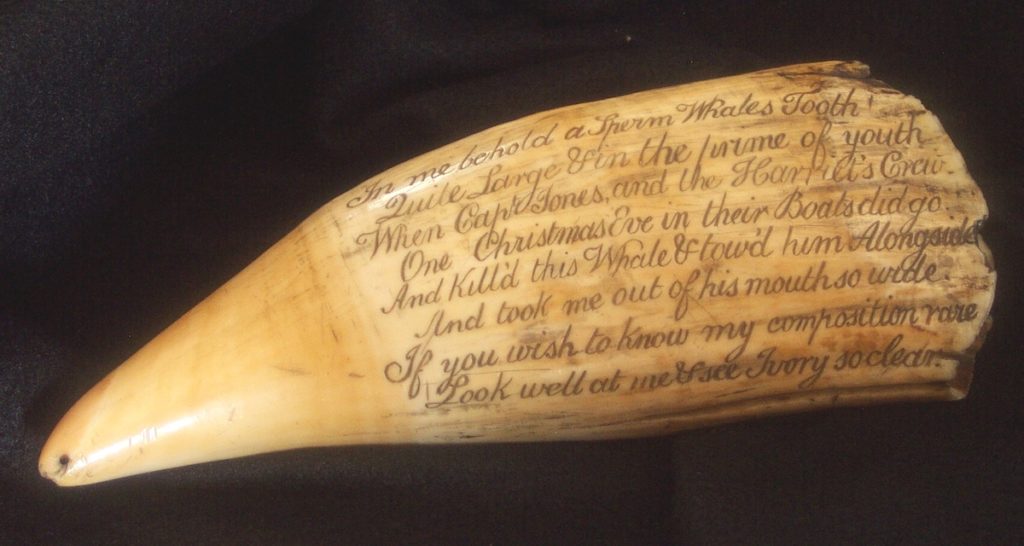Maggie M. Cao
On long voyages that spanned from the Aleutians to the Cape of Good Hope, American whalers introduced a new industrial waste product into global circulation: whale teeth. For the whalemen themselves, the teeth became an artistic material for the novel art of scrimshaw. Scrimshaw describes the transformation of whale bone into a wide range of objects from delicate canes to complex yarn swifts, but the art form is most associated with the pictorially decorated lower teeth of sperm whales, the only great whale with teeth and one of the most hunted species (Fig. 1). On more distant shores, the same whale teeth, some even decorated in scrimshaw, were transformed into monetary and sacred instruments in cross-cultural interactions. How do these two seemingly distinct and distant functions unfold and cohere around a shared material?
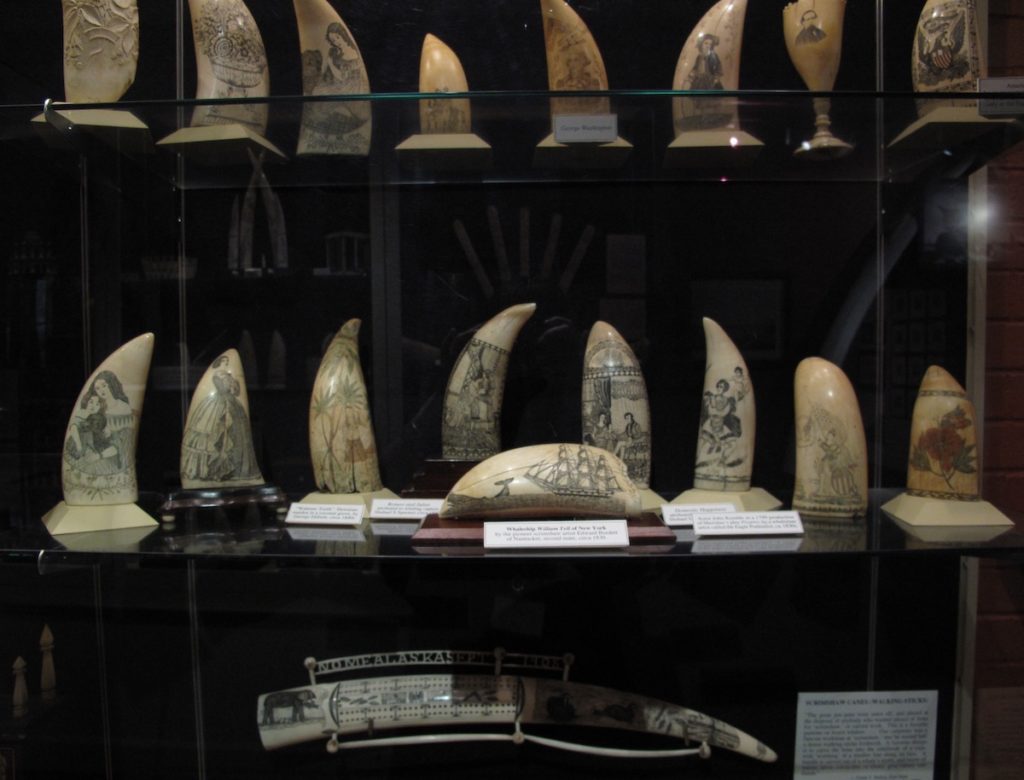
This essay interrogates whale teeth as a maritime medium, tracking the ecological and geopolitical meaning of this novel material through its artistic alterations and transoceanic circulations in the early nineteenth century. Much like the itinerant leviathans from whose mouths they were harvested, these oversized ivories traversed great distances. By following their various migrations—from sea to land and back—this essay considers how an oceanic perspective can reshape the duration, geographies, and environs of the long eighteenth century.
In the project of “worlding” art history, the oceans are often a means and not an end. Art historical studies may be rapidly expanding with discussion of trade routes, islands, and the multitude of artifacts that traversed international waters, but as a discipline, it remains land-bound.[1] In addressing the circulation of bodies, images, and artifacts across oceans, art historians tend to look out to sea from the perspective of dry land—the shores of departure and destination. It is usually terrestrial makers and markets that are of sustained interest. Only recently has the discipline sought to connect oceanic conditions to artistic practice in places where saltwater is part of everyday life.[2] Still, the tendency, particularly in the history of European and American art, is to account for that watery expanse only in the most abstract ways, as an acknowledgment of distance and time lapse.[3] No doubt scholars are biased by their own global experiences, and particularly in the global north, where origins and destinations, however distant, are reachable in a day, and the passage from one to the other is often only a trivial inconvenience. This was hardly the case in the long eighteenth century when traversing the oceans was routine and commonplace, yet slow and precarious. Of course, oceanic precarity was experienced differently across the social spectrum in the eighteenth century. At the privileged extreme were transatlantic crossings that mimicked terrestrial life materially and socially, where precarity emerges only in the event of a shipwreck or other disaster. At the other extreme was the middle passage, which was so filled with violence and terror that it precluded the forms of creativity that is the subject of this essay.
In the past decade, there has been a push in the broader humanities toward ocean studies, sometimes called the “blue humanities,” an approach intersecting with but separate from the environmental humanities.[4] Recent work by media historian Melody Jue pushes us to go even further: to adopt a “milieu-specific analysis” that engages with the ocean as an “environment for thought rather than as an object of analysis or region for the study of cultural representations.”[5] What would it mean to broaden our scope of the long eighteenth century to the seas, and not just as a spatial and temporal gap—that in-between separating production and consumption—but as a site of artistic invention and creativity? To call the ocean a “site” is deliberate here since its evocation of that familiar art historical term “site specificity” is meant to push us into an environmental mindset—one that is attentive to ocean ecologies and our anthropogenic activities upon them.[6]
We still live in a maritime world. 90% of the commodities that Americans consume are moved by ships, and that maritime transportation is central not just to trade, but arguably to the very character and history of global capitalism and imperialism.[7] Yet, most residents of the global north are largely blind to their continued dependence on the sea because their lives are no longer tethered to its winds and currents.[8] Scrimshaw, as we shall see, is not only a direct product of that dependence, but an art form that registers the geographic vastness, temporality, colonial relations, and non-human ecologies of the world’s oceans.
Before diving in (so to speak), readers might wonder whether artifacts of American whaling, which peaked in the 1840s, could be considered part of the long eighteenth century at all. How, indeed, should scholars periodize an ocean-centered art history? What conclusions should be drawn, for instance, from the fortuitous near-alignment of the first steamship crossing the Atlantic in 1819 with Napoleon’s fall in 1815, which is sometimes used to mark the end of the long eighteenth century in British history?[9] Though the advent of steam indicates an important paradigm shift in maritime history, as it does in the broader history of technology and industry, an examination of whaling and its artifacts suggests that oceanic periodization is far from clear-cut. Whaling was one of the last maritime industries to give up sail, relying on the older technology long after steamers had become reliable and commonplace on the oceans. American whalers did not reach global dominance because of technological innovations, but because of geographic expansion—namely from shore-based fisheries to open-sea operations in the 1780s. This moment in the eighteenth century is when scrimshaw first emerged as an art form.[10]
Open sea whaling voyages were long and geographically extensive. They were divided between periods of intense labor, following a successful hunt, and significant lulls as sailors navigated from one hunting ground to another. Scrimshaw was invented as a shipboard pastime precisely for these monotonous periods because it made use of a plentiful material and required no special tools or skills.[11] This art thus grew in tandem with offshore whaling, developing as the voyages themselves expanded and lengthened with the increasing depletion of the world’s whale stock.
If anything, scrimshaw is a medium of temporal tension—a collision point of the eighteenth and nineteenth centuries, the early modern world and industrial modernity. It also registers the diverging temporalities of the oceanic and terrestrial, of handicraft and industry. It is a nineteenth-century art form rooted in an eighteenth-century endeavor. It was made at sea—a doldrums pastime—but it visualized the fast pace of a terrestrial calendar. It was, in other words, a practice that preserved an oceanic temporality of early-modern experience dictated by the technology of sail. Yet it was bound to the image culture of its nineteenth-century terrestrial moment. Scrimshaw is made strange by these tensions. Embracing the oceanic, one shipboard artist added a wide-open fisheye to his whale tooth’s rounded point, even though this detail is entirely disconnected from the broader composition, which features a whaling scene in a floral frame (Fig. 2). The addition makes the tooth at once alive (made animal again by this vivid eye) and dead, a mere surface for inscribing a scene of human violence.
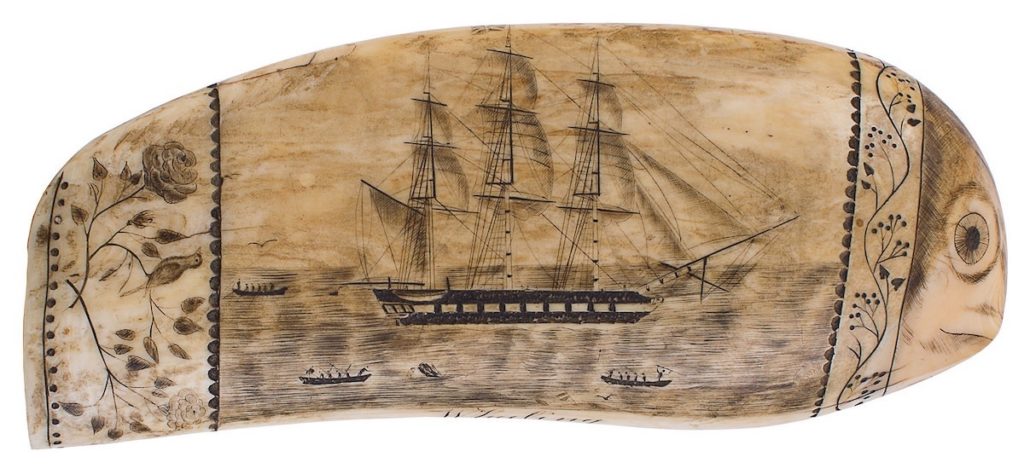
Scrimshaw is also palimpsestic; it is matter that registers the passage of time. Much like a tree’s rings, a sperm whale tooth’s size and marbling patterns correlate to cetacean age.[12] After extraction, surface decoration and inscriptions register human history, particularly when the teeth passed from white whalers to Indigenous people in the Pacific, each leaving their mark. The contradictions and paradoxes of maritime mediums like whale teeth thus destabilize our understanding of fixed geographies and temporalities. How might an oceanic, living medium—whether carefully decorated by American whalers at sea or exchanged in colonial circumstances on a distant shore—prompt a rethinking of the longue durée of the eighteenth century?
Maritime Makers: Scrimshaw and the Sea
Scrimshaw is often regarded as a “folk art”—a classification that while accurate by certain definitions falsely presumes the practice to be nonindustrial, anti-capitalist, and hyperlocal.[13] Nineteenth-century whaling was an industry with extensive ecological and political reach. Herman Melville famously described whalers as the “Alexanders” of the “watery world […] parceling out among them the Atlantic, Pacific, and Indian Oceans.”[14] The pursuit of whales as a natural resource far beyond U.S. borders was undeniably colonial.[15] For a fledgling new republic, whaling gave early Americans a strong claim for international preeminence. By the 1840s, hundreds of American vessels were plying the Pacific and Indian Oceans, supplying the young nation with significant national wealth and the world with fuel for lighting lamps and running machines.[16] The industry quickly generated a global dependence on a non-renewable energy source, leading to overfishing that depleted ocean ecosystems. Whaling vessels were also themselves diverse and polyglot spaces, where white New Englanders worked alongside free Blacks and fugitive slaves seeking freedom at sea, Indigenous Americans from maritime regions, and foreigners (Azoreans, Cape Verdeans, Pacific Islanders, Africans, Asians, Arctic peoples, and white Europeans) who sometimes joined vessels at ports and waystations on route.[17]
Scrimshaw is best understood, then, not as a “traditional” craft, but as a novel product of whaling’s modernity, anchored by global industrial capitalism. In technique, scrimshaw is reminiscent of printing processes though its makers likely had little experience with the mechanics of graphic reproduction. It recalls engraving, sharing with it similar tools of inscription and methods of mark-making. In scrimshaw, whalebone is incised with lines and dots using sharp, burin-like tools such as knife points or sailmakers’ needles. Then, a dark, greasy ink (typically lamp black, a residual soot from burning whale oil for lighting) was applied to the ivory surface, then wiped away so it remained in the bone’s grooves and holes, much as pigments are applied to metal printing plates.
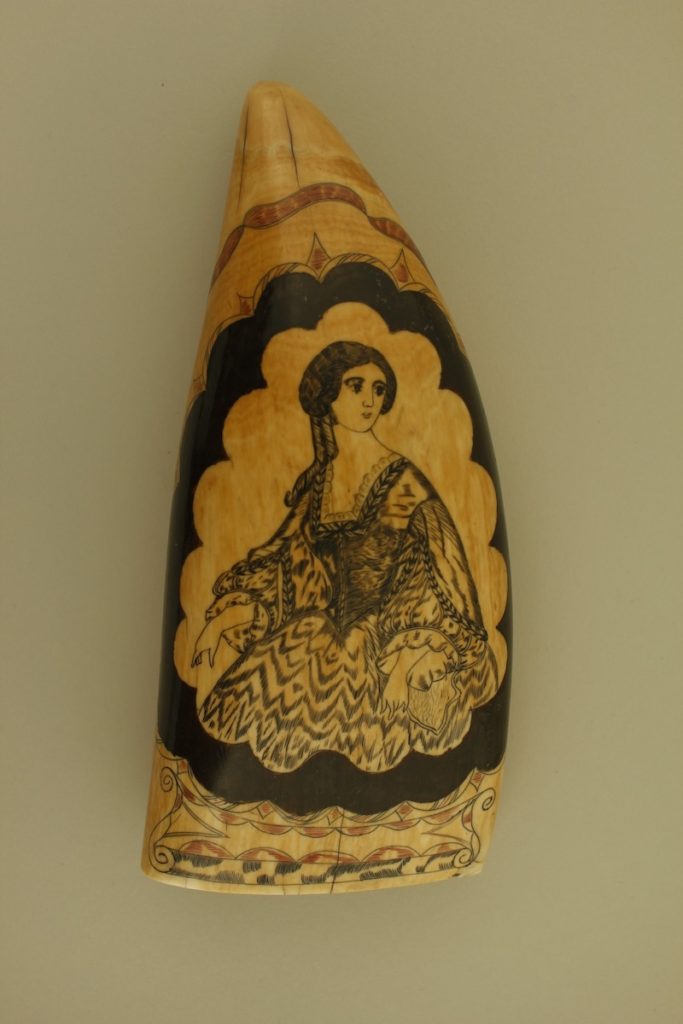
Parallels to printmaking were not just technical. Indeed, printed images from mass media actually served as sources for many scrimshaw designs. Newspapers, magazines, books, and other publications circulated shipboard, as sailors in the period were highly literate, and offered ready images for copying and adaptation from paper to bone. The profusion of print media provided scrimshanders, the makers of scrimshaw, not just with a pictorial but also a technical model for execution in the printed media’s matrix of lines and dots. Material evidence suggests that scrimshanders often transferred source prints by cutting out the original pages, adhering the paper directly to bone, and using pinprick holes to outline the design in the tooth’s enamel. Scrimshaw specialist Stuart Frank has traced the sources for many tooth designs to such popular periodicals as Harper’s Weekly whose fashion plates were common source images.[18]
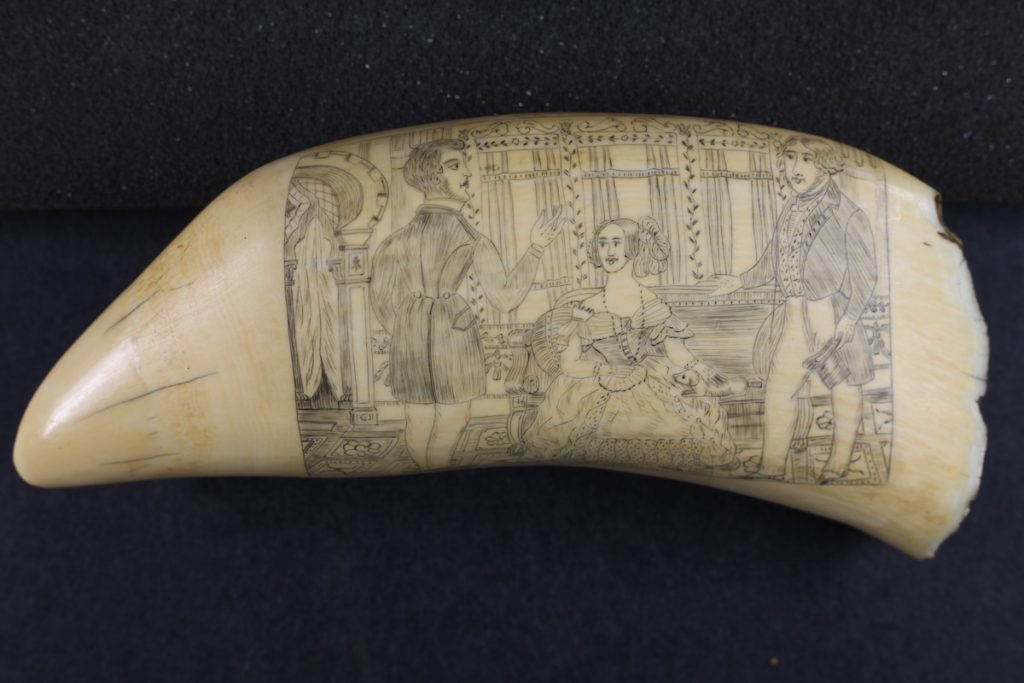
Scrimshaw further preserved its links to mass media in so far as its compositions show a desire for flatness. Although sperm whale teeth have a curved, conical shape, scrimshaw is seldom conceptualized in the round or as sculptural relief. The teeth were typically smaller than the prints used for their designs, so scrimshanders adapted source images by cropping or wrapping them to fit the tooth surface. In one example copied from an 1858 Harper’s Weekly fashion plate, the scrimshander truncated a full-length figure at the hips and encircled her in an ovular decorative frame (Fig. 3). The dramatic black framing draws attention to the female figure and away from the curvature just beyond its borders. The tooth seemingly hides its own shape and volume. At other times, the rectilinear format of the source images is preserved, with the corners of the original composition awkwardly wrapping around the tooth’s curved contours (Fig. 4). In one unusual example, an actual newspaper clipping is pasted to the enamel, the text describing the capture of the very whale whose tooth it covers (Fig. 5). Most decorated teeth are treated as having two distinct sides, each containing unrelated images. In such instances, scrimshaw strives to be all surface—to erase its own dense and unwieldy body (larger teeth are unwieldy indeed, weighing in at two pounds or more).
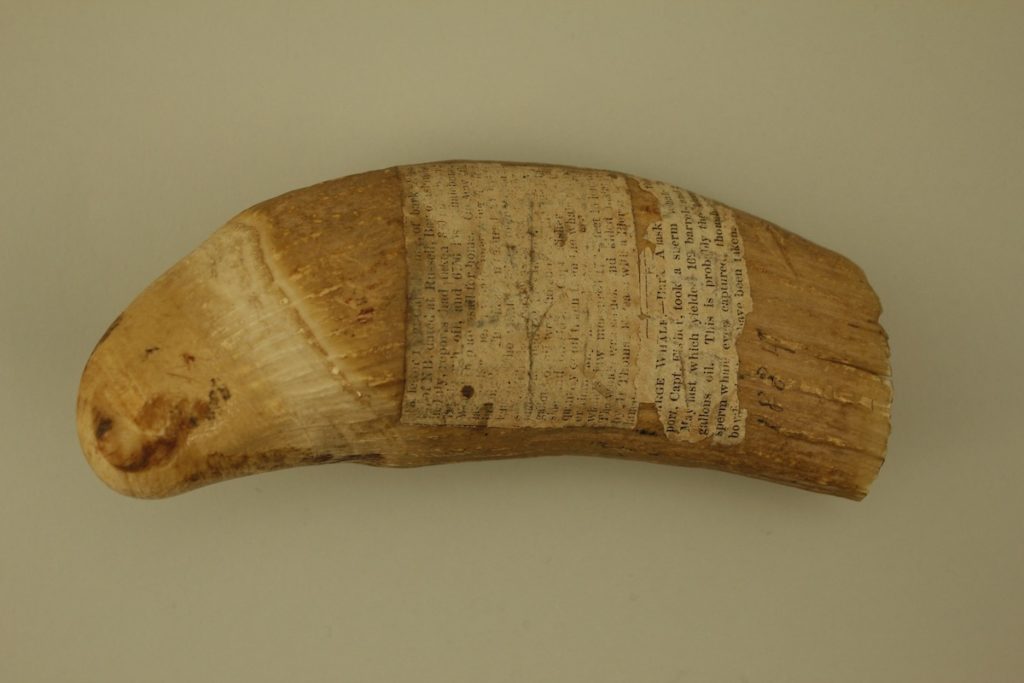
We might look to scrimshaw renderings of whaling itself to best understand this material paradox between surface and body. Although we might expect such scenes to reflect direct observation, this imagery, too, was often copied from print sources. On a tooth featuring a gasping sperm whale baring its teeth as two whaleboats attack it from either side (Fig. 6), only the background ship and small figures have been modified from its print source: a plate in Robert Hamilton’s 1837 Natural History of the Order of Cetacea or Whales. The model image was first drawn by the artist James Stewart on the basis of a textual description published by a ships’ surgeon in 1835 before it was engraved by William Lizers in Hamilton’s volume two years later (Fig. 7). These successive translations—from observation to text, text to drawing, drawing to plate, and print to tooth —mean that the scene incised upon ivory is many times removed from the scrimshander’s lived experience. In other words, despite the medial resonance of representing whale hunting on the very body of a hunted whale, the intervention of a print source (based on a largely imagined and embellished encounter) disconnects the carved image of killing from the actual violence rendered on the animal body.
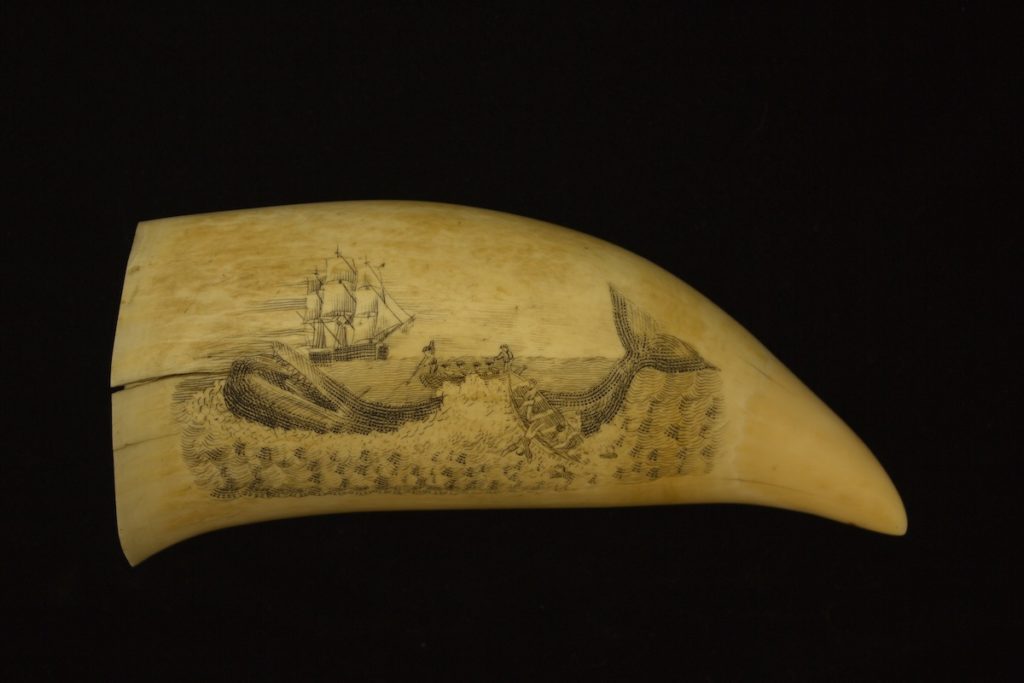
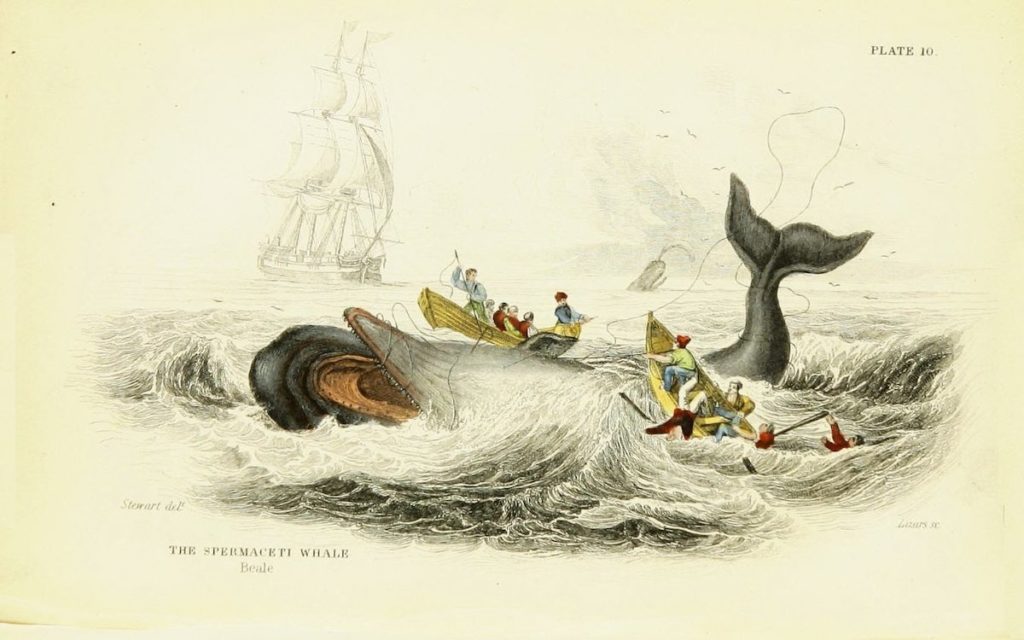
In scrimshaw, technique and physical support are not always aligned. Whale ivory, the material of scrimshaw, connects the practice not to mass media but to singular and sentimental (not to mention organically resonant) artifacts. In the long eighteenth century, animal bone was the preferred material for the popular medium of portrait miniatures. These portable watercolor likenesses, traditionally painted on discs of elephant ivory, helped to maintain social bonds during a period of heightened mobility. To carry a miniature was to affirm ties between viewer and sitter across time and space.[19]
Scrimshaw mimics the miniature’s mode of circulation—the gift exchange—but reverses its geographic trajectory. While miniatures were taken to sea by travelers as reminders of loved ones back home, scrimshaw was produced during ocean crossings to be given to intimates ashore. Ivory was a favored material for the construction of such social bonds because it was, after all, living matter. Not only was animal bone once alive, but its molecular structure is such that even when “dead,” it remains active, growing and shrinking with changes in temperature and humidity. Miniature portraitists capitalized on this enlivening quality. In a posthumous portrait of Harriet Mackey, a bride who died just before her wedding, the miniaturist P.R. Vallée depicted the sitter as if asleep (Fig. 8). The ivory support not only gives her skin a lifelike translucency, but its material contraction and expansion mimics breathing. Framed on the reverse side, moreover, are plaited locks of the sitter’s hair—like bone an indexical and non-decaying remnant of the body.[20]
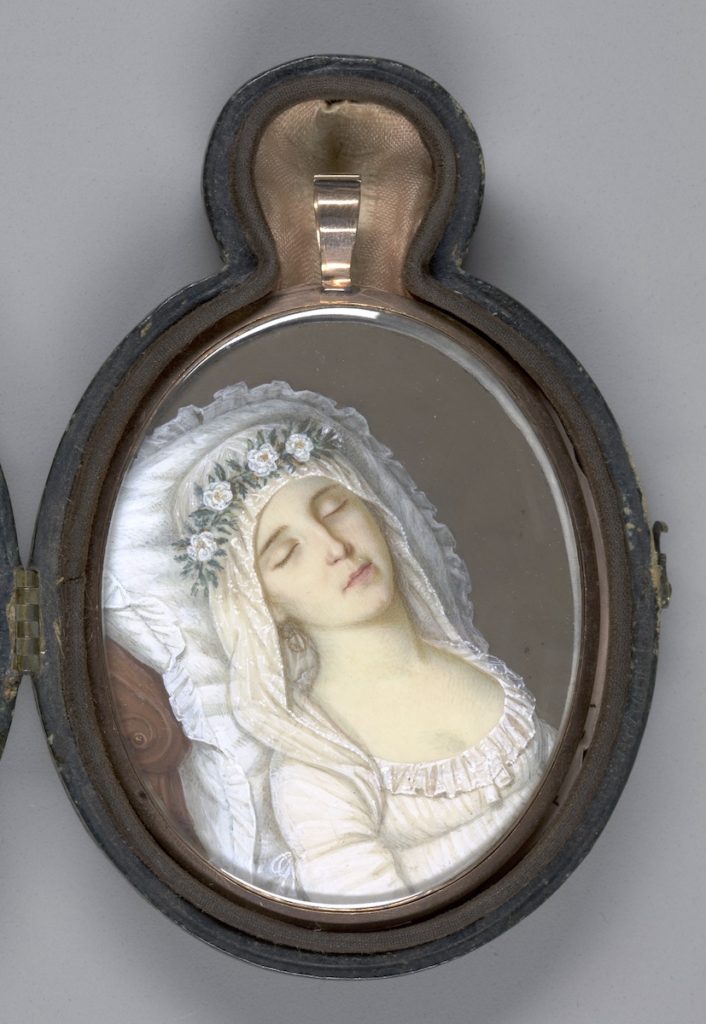
Scrimshanders, too, seem invested in the living quality of their ivory. The drama of animal life and death, which they experienced firsthand, takes center stage in what I call “speaking” teeth, a genre of text-based scrimshaw. An 1821 tooth, for example, is inscribed with a narrative of a whale’s capture and killing and the tooth’s own extraction (Fig. 9). It begins, “In me behold a Sperm Whale’s tooth,” and ends with the lines:
One Christmas Eve in their Boats did go
And kill’d this whale & tow’d Alongside
And took me out of his mouth so wide
If you wish to know my composition rare
Look well at me & see Ivory so clear.
The poetic lines not only give the tooth sentience and voice, but also acknowledge its conversion to an aesthetic object by directing a viewer’s attention to its materiality as “Ivory so clear.”
“Speaking” teeth like the 1821 example offer first-person narratives about their demise in tales of being torn from the mouths of monstrous creatures and their subsequent circulation. Their surfaces are often adorned with maps or itineraries of ports and waystations. In one example, a picture of a rigged ship is accompanied by the factual clause, “This is the tooth of a sperm whale that was caught near the Galapagos Islands by the crew of the ship Adam and made 100 barrels of oil in the year 1817.”[21] Such geographic and temporal actualities are conventionally ignored in mediums where the support is designed to disappear behind the image. Rarely, for instance, do printmakers or painters make note of the origins of their paper or canvas.[22] Instead, speaking teeth recall a popular genre of eighteenth-century fiction: the “it-narrative,” humorous stories narrated from the point of view of inanimate objects. The it-narrative is a genre with close ties to globalization, for it tends to stress the narrating object’s wide circulation as well as its enchantment and disenchantment at the hands of various owners in different parts of the world.[23]
That whale teeth should be called upon to archive the geography and temporality of the whaling voyage is particularly ironic given that the same medium also reminds viewers of animal power and sentience. On the one hand, the textual inscriptions on “speaking” teeth function like an animal trace, registering the movement of animal bodies that whaling ships followed throughout the world’s oceans.[24] As such, they record a form of nonhuman, ecological existence. On the other hand, the very project of recording maps and itineraries on a dead animal body suggests a desire to suppress oceanic enlivenment, replacing it with human epistemologies. The 1831 to 1834 itinerary of the New Bedford whaler Timoleon, which was recorded in the format of a tidy chart on a whale tooth, for instance, could be read as a marker of temporal change within the atemporality of maritime routine—a kind of shipbound equivalent of the prisoner’s hatch-marked cell wall. Indeed, another way to understand the popularity of fashion plates and other mass media images on whale teeth is to see them as another imposition of human temporality. (Represented trends in women’s clothes often provide some of the best evidence for dating scrimshaw today.) In some cases, scrimshaw teeth were later mounted with actual clocks, creating artifacts that literally conjoin the ecological rhythms of the ocean with the rituals of human timekeeping. In one example (Fig. 10), a clock that keeps time is flanked by a pair of teeth decorated with fashion figures, which register sartorially a specific moment in human history. Meanwhile, the base of inlaid mahogany—a wood introduced by maritime expansion into the Caribbean—resembles the structure of a terrestrial plaza or building entrance.[25]
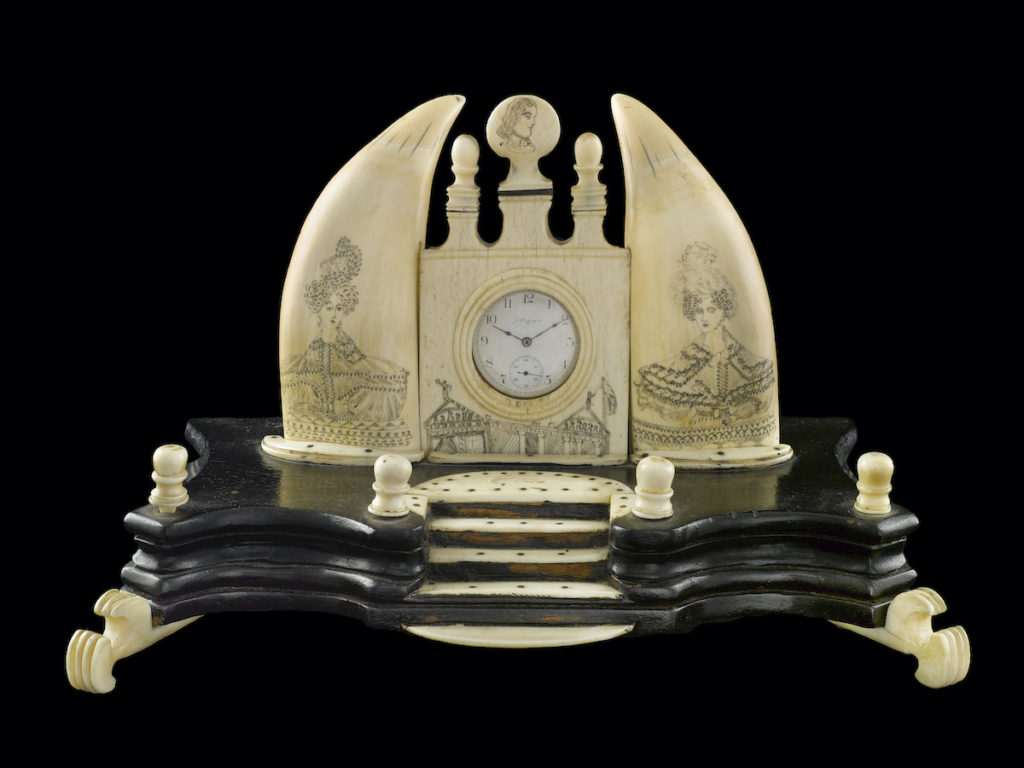
At sea, mass media gives sailors a crucial terrestrial link. The surprisingly widespread practice of shipboard news printing, as Hester Blum has suggested in the case of polar expeditions from the nineteenth century onward, was an effort to maintain regular time in extreme environments such as polar winters which lacked the daily sunrise and sunset of human temporality.[26] On multiyear voyages that moved between the tropics and the poles, whalemen were similarly besought by temporal irregularities and monotony, enduring violent storms and tedious doldrums. The reference to fashion trends along with maps and itineraries on whale teeth direct attention to living material just as much as they divorce that material from life at sea.
Scrimshaw is an art of material ambivalence. Some scrimshanders embraced the sentience of their medium by enlivening teeth with animal bodies and animal stories. Others engaged in decorative programs of disenchantment, flattening the curved bodies of the tooth into a blank space for rectilinear reproductions of human activities. This double meaning of whale teeth—as living being and as dead surface—emerges not just shipboard in scrimshaw but also later at sites of its circulation.
Transactions Ashore: Tabua in Fiji
Scrimshaw was designed to move from sea to shore. Though intended as souvenirs of hunting and voyaging for family and friends in North America, not all carved teeth followed this prescribed route. Whale teeth that strayed tethered their makers to a very different community of users, whose own creative adaptations and conceptions of objecthood speak to the capacity of this maritime medium to shape cross-cultural encounters. One such rerouted tooth is in the collection of Te Papa Tongarewa in Wellington, New Zealand. Its decoration is typical, featuring a full-length female figure dressed in a shawl and fingerless gloves, likely copied from an 1840s fashion plate (Fig. 11). Yet the tooth has been altered in significant ways that mark its later ownership. A woven cord of coconut fibers is attached to holes drilled at the top and bottom. Once hung from the cord, the upright figure no longer stands tall but is reoriented to a prone position. Inverted in this way, a second carving becomes legible. Running horizontally alongside the figure is the inscription “RATU COKA,” a Fijian chiefly name, engraved with decorative flourishes. These alterations mark the tooth’s transformation into tabua, a Fijian sacred object.
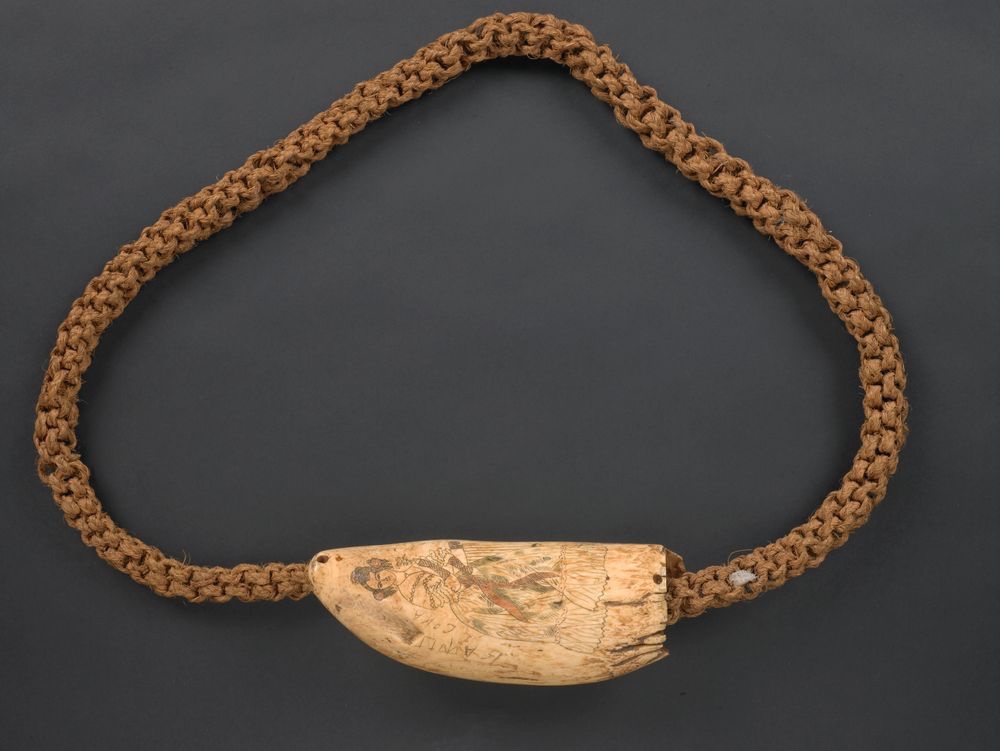
In the nineteenth century, tabua played a major role in facilitating exchanges between Indigenous people and Western visitors to the Melanesian archipelago of Fiji. The term “tabua,” which roughly translates to “sacred,” referred at one time to a class of ceremonial objects in a variety of materials, including wood carved into tooth forms, but after sustained contact with white merchants, the word became synonymous with sperm whale teeth. Tabua are an artifact of maritime globality.[27] Until the late eighteenth century, whale teeth were extremely uncommon in Fiji. Whale bone artifacts along with some teeth were introduced by neighboring Tongan craftsmen, who specialized in ivory bone carvings and inlays, but only with the expansion of the American whaling industry to the world’s oceans did whale teeth begin arriving in Fiji in large quantities.[28]
Most tabua were and are uncarved sperm whale teeth, but examples of engraved scrimshaw-turned-tabua pepper collections both in Fiji and around the world, suggesting that their circulation was not uncommon. In the Wellington tooth’s cultural transformation, the second carver, presumably the named Fijian chief, marked his ownership, but in a way that respected the original decorative scheme. His inscription occupies the “face” of the tooth, alongside the etched figure, and his letters are shaped to nestle into the empty space beside the figure’s waist. Preserved in this incised conversation between two engravers who never met is a further history of encounter, one in which maritime media bridged incompatible economic regimes.
Whalers were not the only mariners engaged in long, transoceanic voyages in the early nineteenth century. On route to Canton (Guangzhou) in China, European and American merchant ships frequented the tropical islands of the Pacific to acquire sandalwood and sea cucumbers, which the Chinese considered luxury goods. There, sperm whale teeth were a prized trade item. “I had been informed,” American naval captain David Porter wrote in 1812, “that hogs, the only animal food on the island, could be purchased for no other article.” By Porter’s account, “ten whales’ teeth of large size” was the going “price” for a shipload of sandalwood.[29] American merchant ships began carrying whale teeth to the Pacific as early as the 1810s. The ship Sultan embarked from Boston in 1815 with a box of 48 teeth separated into three grades along with instructions from the ship owners to the captain for obtaining more “from the Whale Ships you will meet” as “[f]ormerly the Whalemen considered them of little or no value.”[30] Much like other oceanic materials at the center of transcultural relations in early modern exchange, notably cowries and wampum, whale teeth were an instrument of colonial exploitation and of Indigenous agency. Their circulation positioned Fijians as key players in globalization and transformed whalers into inadvertent miners, minters, and craftsmen of tabua.
For Americans in the Pacific, a materially oriented currency from the sea evoked experiences closer to home. Robert Coffin, a whaleman shipwrecked in Fiji in the 1850s, wrote that for the islanders, a whale’s tooth “is as important a treaty article as wampum among our Indians,” referring to the whelk and quahog shell beads woven into belts by Eastern Woodlands tribes.[31] Wampum originated as a treaty-making instrument between warring Indigenous communities, where the unique pictographic imagery of a belt’s design served as mnemonic devices for recalling through oral tradition its diplomatic purpose (Fig. 12). After contact with Europeans, Indigenous communities continued to use wampum to seal social and political agreements, but the shell beads also became a common currency, facilitating trade not just between European and Indigenous communities but also amongst European settlers in the cash-poor colonies. Coffin’s analogy is fitting since both wampum and tabua were Indigenous artifacts that migrated and facilitated interaction between two conflicting regimes of value.[32] As objects of cross-cultural negotiation, whale teeth were active beings for Indigenous recipients who valued them as stand-ins for human relations, while for Western givers, they lacked agency and served simply as monetary instruments.[33]
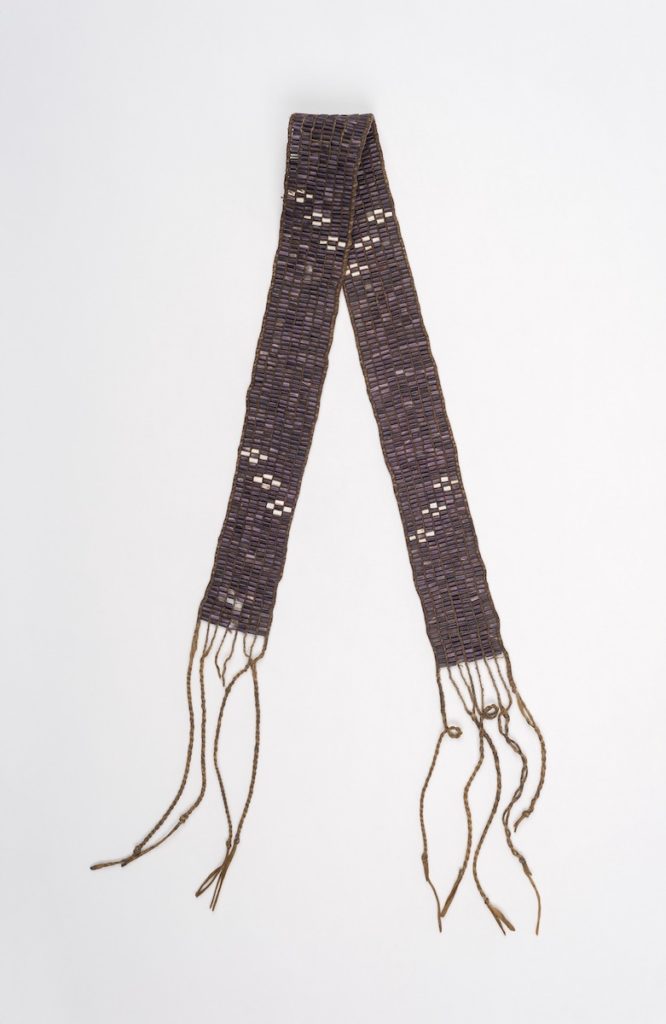
Whale teeth were initially treated by foreign visitors to Fiji as a de facto currency. As valuable objects with no practical utility, early anthropologists placed them midway on a continuum of economic evolution from barter to standardized metallic bullion.[34] But whale teeth defied Western economic logic because they were not fixed to standard weights and measures. Instead, material qualities (size, color, polish, age) and social attributes (the identity of giver and recipient as well as their geographic location) affected a tooth’s usefulness at moments of exchange.[35] After living in Fiji for two years in the 1840s, Englishman John Jackson concluded that although he “used to consider the difference between the white and the red teeth the same as between our shillings and sovereigns,” he later came to realize that these articles were “not exactly as our money, there being no certain value put on them.”[36] A failure to understand the social agency of whale teeth for Indigenous people led foreign merchants to conclude that Fijians showed an “utter ignorance of […] relative value” and simply held a “strange infatuation […] for this strange ornament.”[37]
Engaging with the material excesses of tabua—the sensual and social qualities that contributed to their value uncertainty—can also push us to look beyond the specificity of the port, trading post, or treaty site. In the case of both wampum and tabua, oceanic artifacts of high value were exchanged by groups uninvolved in their production and manufacture. Wampum beads were made from shells gathered and drilled by coastal Indigenous communities until white settlers began mass-producing their own at the end of the eighteenth century.[38] Tabua originated from whaling ships, though this fact has received only passing mention from anthropologists studying Fiji.[39] Before whalers became key nodes of the Fijian trade network, rare whale teeth were brought from Tonga, where whales beached with more frequency due to ocean currents. Seeing that these rare teeth were highly valued, European merchants began presenting chiefs with false tabua—elephant and walrus tusks carved into whale tooth forms.[40] Tabua had, in other words, always signified for Fijians a worldly thing that arrived by way of people across the sea. Moreover, the carving and decoration of whale ivory was always a specialty of non-native craftsmen, first Tongans and later white whalemen.
Bringing whalemen into the picture makes it possible to conceive of tabua in more geographically expansive, more ecologically minded, and ultimately more ocean-centered ways. In the Pacific region, where terrestrial geographies are antithetical to Indigenous epistemologies, it is even more crucial that we address the history of trade and colonialism from ocean-oriented perspectives. Islands, as Indigenous Carolinian scholar Vicente Diaz reminds us, “are a concept constructed by people from ‘the other land form called continents.’”[41] Such imperialist thinking has long marginalized islands and islanders in the Pacific as too small, too poor, and too isolated for economic autonomy. The pioneering Pacific writer and activist Epeli Hau‘ofa’s has long called for a reimagining of Oceania (a name he uses in place of the pejorative “Pacific Islands”) not as “islands in a far sea” but a “sea of islands” and its people as guardians of the world’s largest ocean.[42] The Oceanian worldview, which survives in legends, myths, language, and oral tradition, stresses continuities between land and sea.[43] To focus only on the shore as a site of exchange is to ignore the distant and watery origins of the objects like tabua being exchanged. Historically, Indigenous Oceanians traveled and traded across vast Pacific regions unhindered by the boundaries erected by white mariners who harvested the ocean’s natural resources. In fact, these Indigenous seafarers referenced the migratory routes of whales to build mental maps of time and space. Oceanian seafaring, unlike Western navigation, relies on subjectively experienced environmental cues such as those offered by non-human animals rather than objective maps and charts.[44] Thus, the very imperialist ambitions of the whaling industry, and its depletion of the ecosystem of their choice quarry, went hand in hand with the border-erecting that relegated Oceanians landbound to their “remote” islands.
Whale Teeth as Living Matter and Material Thing
When white merchants established footholds in Fiji, they were surprised to discover that the locals did not procure tabua directly from the sperm whales that annually passed the island chain on their migrations. As one observer reported, they had always “purchased their stock from foreign traders.”[45] Tabua linked Native Fijians to American whalers even if, by and large, the two communities only rarely had direct, sustained contact.[46] Their encounters happened instead through the teeth that passed between them—living matter that in both contexts can be said to oscillate between sacred thing and mere commodity.[47] Both whalers and Indigenous Fijians shared an awareness of whale teeth as a powerful thing from the sea. While anthropologists have long noted the enlivenment of tabua in Indigenous life, art history’s terrestrial orientation has led us to overlook and to forget that scrimshaw was also living matter though dead to its makers.
In Fijian folklore, tabua’s origin is not just foreign but associated with a violent interaction between man and animal. Its origin myth concerns Tabua, a shipwrecked foreigner, who, when charged with performing a miracle before he can marry the chief’s daughters, returns to the site of a beached whale he saw when drifting ashore. He proceeds to pull out the whale’s teeth, knocking out some of his own in the process. When he delivers the large teeth to the chief, he cunningly explains that they had grown from his own. Suitably impressed, the chief agrees to the marriage and declares that in the future, whale teeth be called “tabua,” that such an item is the price of a woman in marriage, and that foreigners who come ashore be killed and eaten.[48] Anthropologists have pointed out that the tabua myth confirms a native distrust of foreigners as trade partners, but none have noted that the image of Tabua’s violent dentistry also recalls the work of American whalemen, who often described the act of striping sperm whales of their teeth as a key moment in breaking down their enormous bodies. Such bloody butchering, one might say, is sublimated through the scrimshanders’ later decorations, which so often covered the teeth with imagery considered feminine and sentimental.[49]
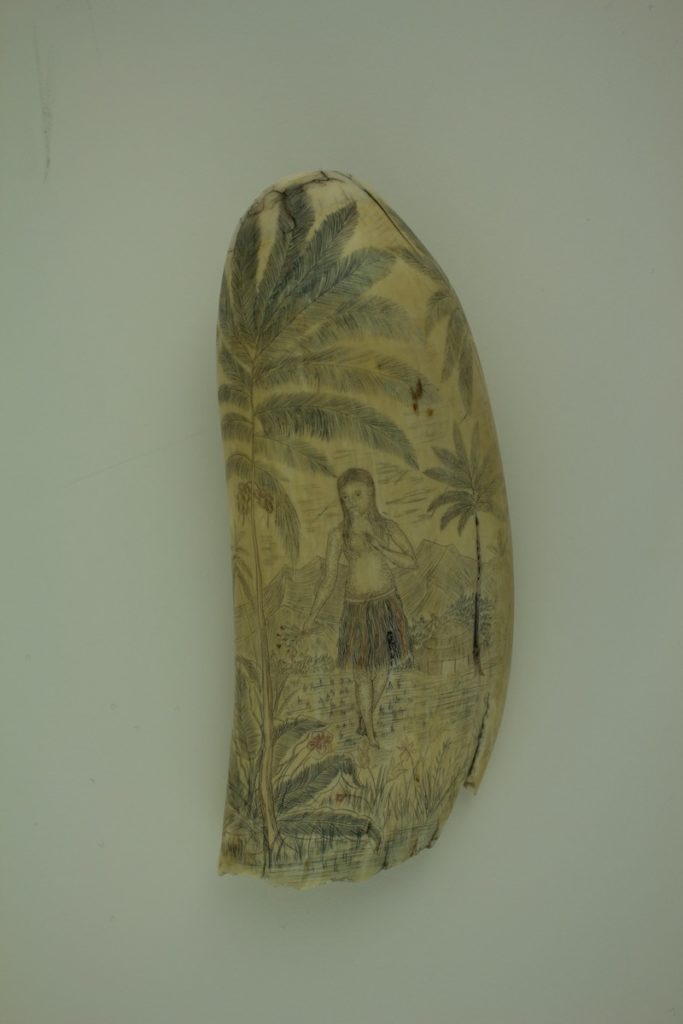
The globality of tabua and its links to a foreign community of hunters and craftsmen is perhaps what prompted Fijian chiefs to value scrimshaw as well as unadorned whale teeth. Converting scrimshaw into tabua can be understood as a form of cross-cultural consumption. Just as scrimshanders sometimes etched their ivories with Indigenous figures encountered in the Pacific (Fig. 13), so too could Fijians—through scrimshaw—behold and claim ownership of the Western bodies represented on their surfaces. Fijians sometimes inscribed tabuas with sequences of letters that register a history of ownership or circulation. In one example, where the prominent inscription on a polished and drilled tooth reads “WILLIAME BALEINASUVA,” the Indigenous engraver seems to reference the tradition of scrimshaw itself by placing his inscription centrally on the tooth’s face and mimicking the printed, serif type used in nineteenth-century mass media (Fig. 14).[50] While we have no records of how scrimshaw was valued in nineteenth-century Fiji in comparison with uncarved teeth—whether as a novelty or reserved for specific social functions—their acceptance as tabua is nevertheless significant. Foreign merchants may have given scrimshaw indiscriminately since they acquired their stock from whalemen, but Fijians, who were particularly invested in the material qualities of tabua, were most likely attuned to their difference. In valuing whalemen’s decorations, Fijians also demonstrated their acute awareness of the geographic and ecological reach of their local transactions.
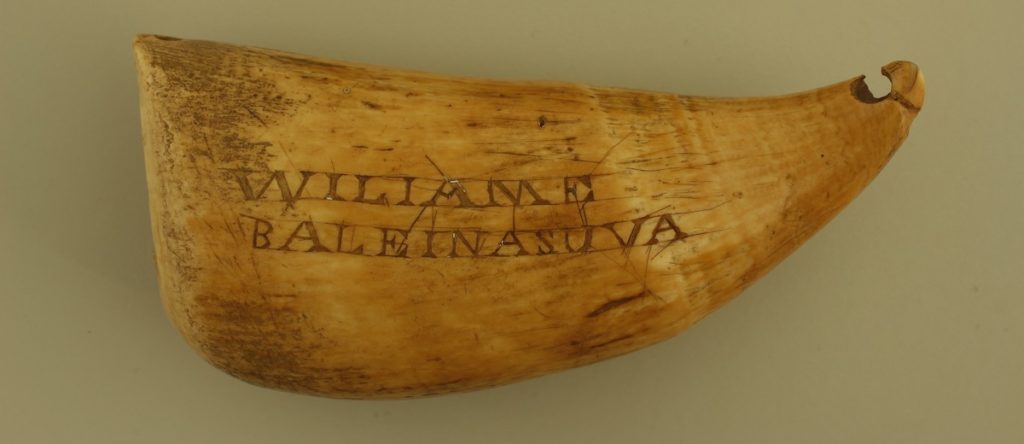
Whale teeth continue to circulate both within and beyond Fiji today though their movements are highly determined by the ecological consequences of American whaling two centuries ago. Many contemporary ceremonial occasions of personal or political import in Fiji—marriages, births, deaths, and various state and diplomatic events—require the presentation of tabua.[51] Yet as a result of the moratorium on whaling, tabua can now only be acquired at urban pawn shops, which are run exclusively by Indo-Fijians—descendants of South Asian indentured laborers who were brought to the islands by British colonizers in the late nineteenth and early twentieth centuries. Just as the beach and the port were once the site of cross-cultural exchange, today similar interactions take place inside the pawn shop, where nonindigenous shopkeepers engage in secretive transactions with Indigenous Fijians, who are loath to admit to trading their tabua.[52] As Peter Stallybrass reminds us, the pawnshop is a space where the “the double life of things” is vividly on display, where things oscillate between their function as repositories of memory and meaning and their value as impersonal commodities.[53] For Indigenous Fijians and non-native settlers both past and present, whale teeth are things at once inalienable and commodifiable, alive and dead. Tabua have long been artifacts linking precolonial practices to global capitalism. Those covered in scrimshaw only made that temporal and geographic collision of contexts ever more visible.
Since 1972, the Marine Mammal Protection Act has prevented whale teeth from legally crossing national borders: they are now extremely rare outside of Fiji. This has led Tongan ivory carvers to frequent Fiji’s pawnshops to furtively acquire the materials for their art.[54] Their contemporary transformation of tabua into Polynesian-style ornamental sculptures and fish hooks for global tourist markets in settler-colonial islands like New Zealand and Hawai‘i is a historical inversion of the trade patterns that originally brought whale ivory to Fiji. Despite human attempts to arrest their movement, whale teeth continue their oceanic circulations.
With each successive modification, whale ivory becomes a palimpsest of ecological, colonial, Indigenous, and global traces. As a maritime medium, it speaks to intersecting narratives of encounter—first interspecies and later intercultural—which reveals tensions between sentimental and industrial, value and waste, being and thing. Untangling maritime media’s complexities reveals the linked course of ecological and colonial histories that constitutes the long eighteenth century. Tracing such an oceanic perspective allows art historians to reimagine these narratives within the expanded and unstable geographic and temporal spaces of the sea.
Maggie M. Cao is Assistant Professor of Art History at the University of North Carolina, Chapel Hill, NC
Acknowledgments: This essay would not have been possible without the generosity of collections staff and curators at the New Bedford Whaling Museum, The Fiji Museum, Te Papa Tongarewa, and the Museum of Archaeology and Anthropology at the University of Cambridge. I am grateful to Sarah Betzer and Dipti Khera for inviting me to participate in this special issue and for being such thoughtful, effective, and efficient editors. This essay’s development is much indebted to my fellow contributors, whose own impressive research and generous feedback have led to many thought-provoking and productive conversations. Thanks lastly to the two anonymous reviewers who offered many invaluable suggestions for revision.
[1] Art historical approaches to oceanic spaces are built on cultural histories such as Paul Gilroy, The Black Atlantic: Modernity and Double Consciousness (Cambridge, MA: Harvard University Press, 1993), which suggests that nation or continent-based studies of culture were inadequate for understanding the Middle Passage. A more recent work in this vein is Tiffany Lethabo King, The Black Shoals: Offshore Formations of Black and Native Studies (Durham, NC: Duke University Press, 2019).
[2] Tatiana Flores and Michelle A. Stephens, eds., Relational Undercurrents: Contemporary Art of the Caribbean Archipelago (Long Beach, CA: Museum of Latin American Art, 2017); Prita Meier and Allyson Purpura, eds., World on the Horizon: Swahili Arts across the Indian Ocean (Champaign, IL: Krannert Art Museum and Kinkead Pavilion, 2018); and Sugata Ray and Venugopal Maddipati, eds., Water Histories of South Asia: The Materiality of Liquescence (London: Routledge, 2019).
[3] See, for instance, Jennifer L. Roberts, Transporting Visions: The Movement of Images in Early America (Berkeley: University of California Press, 2014); Claudia Swan, Rarities of These Lands: Art, Trade, and Diplomacy in the Dutch Republic (Princeton, NJ: Princeton University Press, 2021); and Matthew C. Hunter, “The Cunning of Sir Sloushua: Reynolds, the Sea, and Risk,” Grey Room 69 (Fall 2017), 80-107.
[4] See, for example, the special section on Oceanic Studies, “Theories and Methodologies,” PMLA 125 (May 2010), 657-736; John R. Gillis, “The Blue Humanities,” Humanities 34 (May/June 2013), https://www.neh.gov/humanities/2013/mayjune/feature/the-blue-humanities (accessed October 19, 2021); and Steven Mentz, “Toward a Blue Cultural Studies: The Sea, Maritime Culture, and Early Modern English Literature,” Literature Compass 6 (2009), 997-1013.
[5] Melody Jue, Wild Blue Media: Thinking through Seawater (Durham: Duke University Press, 2020), 16.
[6] Site specificity is closely linked to Land Art of the 1960s and later. That movement involved making art directly in the landscape such that artworks were affected in fundamental ways by environmental conditions and change. I suggest that even though maritime media as I understand it does not necessarily stay in the ocean, it is nevertheless ecologically embedded in the environment of its making.
[7] See for instance, Laleh Khalili, Sinews of War and Trade: Shipping and Capitalism in the Arabian Peninsula (Brooklyn, NY: Verso Books, 2020).
[8] The shift to steam-powered shipping not only accelerated globalization, but also had a profound impact on global economic relations. See Luigi Pascali, “The Wind of Change: Maritime Technology, Trade, and Economic Development,” American Economic Review 107 (September 2017), 2821-54.
[9] While the end of the long eighteenth century is not definitive, 1815 is often used in British history. For example, Paul Langford’s The Eighteenth Century (Oxford: Oxford University Press, 2002), a volume in the series Short Oxford History of the British Isles, marks the century’s beginning and end as 1688-1815 in its subtitle.
[10] Whale bone artifacts were produced earlier in European and Norse communities, but they were made by artisans ashore and never from sperm whale teeth. The earliest shipboard scrimshaw using sperm whale teeth has been linked to British as well as American open-sea vessels.
[11] On the history of scrimshaw, see Stuart M. Frank, Ingenious Contrivances, Curiously Carved: Scrimshaw in the New Bedford Whaling Museum (Boston: David R. Godine, 2012); Nina Hellman and Normal Brouwer, A Mariner’s Fancy: The Whaleman’s Art of Scrimshaw (New York: South Street Seaport Museum and Balsam Press, 1992); and Stuart M. Frank and Jeffrey S. Allen, Scrimshaw on Nantucket: The Collection of the Nantucket Historical Association (Nantucket, MA: Nantucket Historical Association, 2019).
[12] J. Bow and C. Purday, “A Method of Preparing Sperm Whale Teeth for Age Determination,” Nature 210 (1966), 437–438.
[13] The definition of “folk art” is and has always been unstable, particularly in the early American context, where untrained artisans were long presumed, incorrectly, to operate in isolation from global capitalism and its forces. Michael Owen Jones, The Hand Made Object and its Maker (Berkeley, CA: University of California Press, 1975). For a revisionist account of “folk art” in the early United States, see David Jaffee, A New Nation of Goods: The Material Culture of Early America (Philadelphia, PA: University of Pennsylvania Press, 2010).
[14] Herman Melville, Moby-Dick (Boston, MA: W. W. Norton &, Incorporated, 2001), 65.
[15] On whaling and empire, see Richard Ellis, Men and Whales (New York, NY: Knopf, 1991); Philip Hoare, Leviathan, or the Whale (London: Fourth Estate, 2008); and Graham Huggan, Colonialism, Culture, Whales: The Cetacean Quartet (London: Bloomsbury Academic, 2018). American whalers were perhaps the first people to recognize the complexities of sovereignty claims on ocean space, which are today rampant as states and organizations seek to establish influence, ownership, and control of increasingly scarce traditional resources like fish and newly accessible commodities like deep-sea minerals. On oceans as territory, see Elizabeth Havice and Anna Zalik, “Ocean Frontiers: Epistemologies, Jurisdictions, Commodifications,” International Social Science Journal 68 (September-December 2018), 219-235.
[16] On the history of the American whaling industry, see Eric Jay Dolin, Leviathan: The History of Whaling in America (New York, NY: Norton, 2007); Lance E. Davis et. al., In Pursuit of Leviathan: Technology, Institutions, Productivity, and Profits in American Whaling, 1816-1906 (Chicago, IL: University of Chicago Press, 1997); and D. Graham Burnett, Trying Leviathan: The Nineteenth-Century New York Court Case that Put the Whale on Trial and Challenged the Order of Nature (Princeton, NJ: Princeton University Press, 2007).
[17] On board whaleships, racial and ethnic differences were used to reinforce rank, but by the sailors’ own accounts, social bonds made at sea also transcended such differences. On diversity in the whaling industry, see Nancy Shoemaker, Native American Whalemen and the World: Indigenous Encounters and the Contingency of Race (Chapel Hill, NC: The University of North Carolina Press, 2015); Jennifer Schell, A Bold and Hardy Race of Men: The Lives and Literatures of American Whalemen (Amherst, MA: University of Massachusetts Press, 2013); and Martha S. Putney, Black Sailors: Afro-American Merchant Seaman and Whalemen Prior to the Civil War (Westport, CT: Greenwood Press, 1987).
[18] Frank, Ingenious Contrivances, especially 90-99 for fashion plate examples.
[19] Marcia Pointon, “‘Surrounded with Brilliants’: Miniature Portraits in Eighteenth-Century England,” Art Bulletin 83:1 (March 2001), 48-71.
[20] Robin Jaffee Frank, “The Dead Bride,” The Yale Journal of Criticism 11:1 (1998), 69-78.
[21] Inscription on scrimshaw made by a sailor onboard of the whaler Adam, 1817, New Bedford Whaling Museum.
[22] This ignorance of origins only increases in the nineteenth century as such art materials became increasingly mass manufactured commodities. In some cases, eighteenth- and nineteenth-century artists did seek out specific supports such as antique or imported papers for printmaking, which, while not marked by the artist, do often retain visible watermarks that make their place of origin identifiable. See, for example, A. Dawn, “A Method For Examining And Classifying Japanese Papers Used By Artists in the Late 19th-Century,” Studies in the History of Art 41 (1993), 104-131.
[23] A quintessential example of an it-narrative is Joseph Addison’s “Adventures of a Shilling,” The Tatler, No. 249, November 11, 1710. On this genre, see Mark Blackwell, The Secret Life of Things: Animals, Objects, and It-Narratives in Eighteenth-Century England (Lewisburg, PA: Bucknell University Press, 2007).
[24] On the idea of the animal trace as a form of nonhuman agency, see Etienne Benson, “Animal Writes: Historiography, Disciplinarity, and the Animal Trace,” in Making Animal Meaning, ed. Linda Kalof and Georgina M. Montgomery (East Lansing, MI: Michigan State University Press, 2011), 3-16.
[25] On the history of mahogany in relation to American maritime expansion and ecological devastation in the Caribbean, see Jennifer L. Anderson, Mahogany: The Costs of Luxury in Early America (Cambridge, MA: Harvard University Press, 2012).
[26] Hester Blum, News at the Ends of the Earth: The Print Culture of Polar Exploration (Durham, NC: Duke University Press, 2019).
[27] Nicholas Thomas, Entangled Objects: Exchange, Material Culture, and Colonialism in the Pacific (Cambridge: Harvard University Press, 1991), 66-75, 110-118.
[28] “Jackson’s Narrative” in John Elphinstone Erskin, Journal of a Cruise Among the Islands of the Western Pacific, Including Feejees and Others Inhabited by the Polynesian Negro Races, in Her Majesty’s Ship Havannah (London: John Murray, 1853), 439.
[29] David Porter, Journal of a Cruise made to the Pacific Ocean, 2nd ed. (New York, NY: Wiley & Halsted, 1822), 21-22.
[30] Quoted in Frank, Ingenious Contrivances, 11.
[31] The Last of the “Logan”: The True Adventures of Robert Coffin, Mariner, in the Years 1854 to 1859 (Ithaca, NY: Cornell University Press, 1941), 39.
[32] Marc Shell, Wampum and the Origins of American Money (Urbana, IL: University of Illinois Press, 2013); and David Graeber, “Wampum and Social Creativity among the Iroquois” in Toward an Anthropological Theory of Value: The False Coin and Our Own Dreams (New York, NY: Palgrave, 2001), 117-149.
[33] Steven Hooper, “‘Supreme Among Our Valuables’: Whale Teeth Tabua, Chiefship and Power in Eastern Fiji,” Journal of Polynesian Society 122:3 (June 2013), 103-160.
[34] This conception dates from the earliest accounts of Fijian exchange from the turn of the nineteenth century to the seminal anthropological studies of the early twentieth century, such as Marcel Mauss’s 1925 The Gift: The Form and Reason for Exchange in Archaic Societies, trans. W.D. Halls (New York, NY: W.W. Norton, 1990).
[35] D. Graham Burnett, “Relational Economics: Tabua and the Question of Currency,” Cabinet 50 (Summer 2013), https://www.cabinetmagazine.org/issues/50/burnett.php (accessed October 18, 2021).
[36] “Jackson’s narrative,” 439.
[37] Porter, Journal of a Cruise made to the Pacific Ocean, 22.
[38] The Fijian case differs from other Pacific examples of material money, which tended to be locally crafted artifacts with monetary function. See, for instance, Jocelyn Linniken, “Fine Mats and Money: Contending Exchange Paradigms in Colonial Samoa,” Anthropological Quarterly 64:1(January 1991), 1-13.
[39] Hooper, “‘Supreme Among Our Valuables’,” 103-160.
[40] Fergus Clunie, Yalo i Viti/Shades of Viti: A Fiji Museum Catalogue (Suva: Fiji Museum, 1986), 148.
[41] Vincente Diaz, “No Island is an Island,” in Native Studies Keywords, ed. Stephanie Teves et al. (Tucson: The University of Arizona Press, 2015), 90-108.
[42] Epeli Hau‘ofa, “Our Sea of Islands,” in A New Oceania: Rediscovering our Sea of Islands, ed. Epeli Hauʻofa et. al. (Suva: School of Social and Economic Development, The University of the South Pacific,1993), 27-40.
[43] In Fiji, the word vanua, which is usually translated simply as “land,” is actually a far more expansive concept that signifies the interrelation of community and environment, the latter of which encompasses both land and ocean. See Maebh Long, “Vanua in the Anthropocene: Relationality and Sea Level Rise in Fiji,” Symplokē 26 (2018), 51-70.
[44] Diaz, “No Island is an Island,” 90-108; and Paul D’Arcy, People of the Sea: Environment, Identity, and History in Oceania (Honolulu, HI: University of Hawaii Press, 2006).
[45] Berthold Seemann, Viti: Account of a Government Mission to the Vitian or Fijian Islands in the Years 1860-61 (Cambridge: MacMillan & Co, 1862), 381.
[46] Direct contact was often limited to white whalemen turned beachcombers in Fiji—such as Nantucket natives William S. Cary and David Whippy, who in 1826 met again in Fiji while both were castaways serving as envoys of powerful Indigenous chiefs—or Indigenous sailors recruited to join whaling ventures in the Pacific. See Edward D. Melillo, “Making Sea Cucumbers Out of Whales’ Teeth: Nantucket Castaways and Encounters of Value in Nineteenth-Century Fiji,” Environmental History 20 (July 2015), 449-474.
[47] Thomas, Entangled Objects, 110-118.
[48] Thomas, Entangled Objects, 70.
[49] The gendering of scrimshaw, while not the subject of this essay, is worthy of further inquiry. Fashion plates were consumer-facing images designed for female readership, but they were reproduced by male artists in the highly homosocial spaces of whaling ships. Indeed, many scrimshaw artifacts, from pie crimpers and needlework tools to corsets, were gendered female. Historians and collectors of scrimshaw tend to offer the simple explanation that male scrimshanders produced them for female users on shore, but the very time and care male creators spent with such images and objects has, in my view, not been fully considered.
[50] According to the New Bedford Museum files, the inscription likely signifies “William who fell in Suva” if translated from Fijian.
[51] On tabua in contemporary Fijian culture, see Solrun Williksen-Bakker, “Ceremony and Embodied Memory in Urbanized Fijian Culture,” Bijdragen Tot De Taal-, Land- En Volkenkunde 151 (1995), 218–234; Matti Eräsaari, “‘We are the Originals’: A Study of Value in Fiji,” (Ph.D. Dissertation: University of Helsinki, 2013), 125-163; and Serena Solomon, “In Fiji, Nothing Says ‘I Love You’ Like a Sperm Whale Tooth,” New York Times, April 11, 2017, accessed online https://www.nytimes.com/2017/04/11/world/asia/suva-fiji-tabua.html (accessed October 18, 2021).
[52] Paul Van der Grijp, “Tabua Business: Re-Circulation of Whale Teeth and Bone Valuables in the Central Pacific” Journal of Polynesian Society 116 (September 2007), 341-356. It is worth noting that tabua are often kept out of view and locked away in the pawn shops where they are sold today.
[53] Peter Stallybrass, “Marx’s Coat,” in Border Fetishisms: Material Objects in Unstable Spaces, ed. Patricia Spyer (New York, NY: Routledge: 1998), 195.
[54] Van der Grijp, “Tabua Business,” 341-356.
Cite this article as: Maggie M. Cao, “Maritime Media and the Long Eighteenth Century”, Journal18, Issue 12 The ‘Long’ 18th Century? (Fall 2021), https://www.journal18.org/5922.
Licence: CC BY-NC
Journal18 is published under a Creative Commons CC BY-NC International 4.0 license. Use of any content published in Journal18 must be for non-commercial purposes and appropriate credit must be given to the author of the content. Details for appropriate citation appear above.

